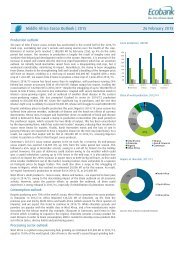www.ebook777.com
Make_Getting_Started_with_Processing_Second_Edition
Make_Getting_Started_with_Processing_Second_Edition
Create successful ePaper yourself
Turn your PDF publications into a flip-book with our unique Google optimized e-Paper software.
10/Objects<br />
Object-oriented programming (OOP) is a<br />
different way to think about your programs.<br />
Although the term “objectoriented<br />
programming” may sound<br />
intimidating, there’s good news: you’ve<br />
been working with objects since Chapter<br />
7, when you started using PImage,<br />
PFont, String, and PShape. Unlike the<br />
primitive data types boolean, int, and<br />
float, which can store only one value, an<br />
object can store many. But that’s only a<br />
part of the story. Objects are also a way<br />
to group variables with related functions.<br />
Because you already know how to work<br />
with variables and functions, objects simply<br />
combine what you’ve already learned<br />
into a more understandable package.<br />
Objects are important, because they break up ideas into smaller<br />
building blocks. This mirrors the natural world where, for<br />
instance, organs are made of tissue, tissue is made of cells, and<br />
so on. Similarly, as your code becomes more complicated, you<br />
must think in terms of smaller structures that form more complicated<br />
ones. It’s easier to write and maintain smaller, understandable<br />
pieces of code that work together than it is to write<br />
one large piece of code that does everything at once.<br />
135



